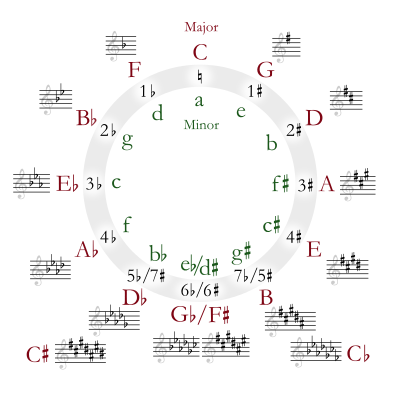F-sharp major
 | |
| Relative key |
D♯ minor enharmonic: E♭ minor |
|---|---|
| Parallel key | F♯ minor |
| Dominant key |
C♯ major enharmonic: D♭ major |
| Subdominant | B major |
| Enharmonic | G♭ major |
| Component pitches | |
| F♯, G♯, A♯, B, C♯, D♯, E♯, F♯ | |
F♯ major or F-sharp major is a major scale based on F♯, consisting of the pitches F♯, G♯, A♯, B, C♯, D♯, and E♯. Its key signature has six sharps.[1]
Its relative minor is D♯ minor (or enharmonically E♭ minor). Its parallel minor is F♯ minor. Its enharmonic equivalent is G♭ major. In writing music for transposing instruments in B-flat or E-flat, it is preferable to use a G-flat rather than an F-sharp key signature.
F-sharp major is the key of the minuet in Joseph Haydn's "Farewell" Symphony, of Beethoven's Piano Sonata, Op. 78, of Chopin's Barcarolle, of Liszt's Hungarian Rhapsody No. 2, of Mahler's unfinished Tenth Symphony, of Erich Korngold's Symphony Op. 40, of Scriabin's Fourth Sonata, and Smash Mouth's All Star. The key was the favourite tonality of Olivier Messiaen, who used it repeatedly throughout his work to express his most exciting or transcendent moods, most notably in the Turangalîla Symphony.
In a few scores, the F-sharp major key signature in the bass clef is written with the sharp for the A on the top line.
Like G♭ major, this key is rarely used in orchestral music, other than in passing. It is more common in piano music, such as the sonatas of Scriabin and Grieg's Lyric Piece, Til Våren.
The Presentation of the Rose scene in act two of Richard Strauss's opera Der Rosenkavalier is written in F-sharp major.
References
- ↑ Frederic Woodman Root (1874). The Song Era: A Book of Instruction and Music for Elementary and Advanced Singing Classes, Choirs, Institutes and Conventions. John Church. p. 9.
External links
 Media related to F-sharp major at Wikimedia Commons
Media related to F-sharp major at Wikimedia Commons- List of instrumental music in F-sharp major
| Diatonic scales and keys | |||||||||||||||||||||||||||||||||||||||||||||||||||||||
|---|---|---|---|---|---|---|---|---|---|---|---|---|---|---|---|---|---|---|---|---|---|---|---|---|---|---|---|---|---|---|---|---|---|---|---|---|---|---|---|---|---|---|---|---|---|---|---|---|---|---|---|---|---|---|---|
 |
| ||||||||||||||||||||||||||||||||||||||||||||||||||||||
| The table indicates the number of sharps or flats in each scale. Minor scales are written in lower case. | |||||||||||||||||||||||||||||||||||||||||||||||||||||||